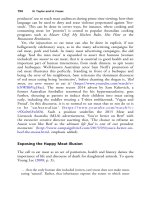The palgrave international handbook of a 221
Bạn đang xem bản rút gọn của tài liệu. Xem và tải ngay bản đầy đủ của tài liệu tại đây (25.75 KB, 1 trang )
216
A. Nurse
for charges to be laid in respect of items used to commit an offence such as
cars or maps of bird breeding sites. While the obsession of offenders gives
some clue to their behaviour, egg collecting is a peculiar activity that defies
ready explanation. In these times of environmental awareness it seems odd
that a form of crime from which the offender derives no financial benefit
should continue.
Case Study 2: Taxidermy and Trophy Collection
While taxidermy and trophy hunting are arguably distinct activities; they
share a common ‘interest’ in the collection of dead animal species and
classification as hobby-related activities (Nurse 2013a, 2011). Neither taxidermy nor sport and trophy hunting are inherently unlawful, albeit they are
regulated activities. Yet research indicates that illegality and corruption are
endemic in the sport and trophy hunting industries and, separate from the
lawful killing of small numbers of animals carried out under permit and
quota systems, a wider problem of the illegal killing of protected animals and
collection or harvesting of their parts for trophies or animal products exists
(see for example Bever 2015 and Crowley 2015 and discussions of the recent
Cecil the Lion case). Trophy hunting thus contributes to other illegal trades
and has implications beyond its immediate animal harm activities. Trophy
hunting in African countries also represents continued dominance by western societies over the developing world. Although African hunting is not
exclusively carried out by white male hunters, this group makes up a
significant proportion of hunters in part because of the socio-economic
considerations that are determining factors in hunting. Kotler et al. (2008)
identified that the price fixed by hunting companies is determined by market
rules and that while prices need to be adjusted to meet demand, the perceived
value of the trophy is a significant factor in determining price. Palazy et al.
(2012) identified that human attraction to rarity is a pricing factor, thus
inevitably the rarer and more challenging species are more expensive to hunt
and attract hunters from more affluent backgrounds willing and able to pay a
‘rarity’ premium. Sport and trophy hunting inevitably attract those individuals disposed towards direct animal harm and for whom the notion of
animal rights and species justice is, at best, secondary to their own interests
(Nurse 2013a). The animal abuse associated with sport and trophy hunting
consists of deliberately exercising power over an animal by consciously taking
its life. However, sport hunting, aimed at smaller species, perhaps lays more









